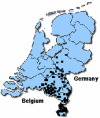Etiology and prognosis of pregnancy-related pelvic girdle pain; design of a longitudinal study
- PMID: 15627405
- PMCID: PMC548283
- DOI: 10.1186/1471-2458-5-1
Etiology and prognosis of pregnancy-related pelvic girdle pain; design of a longitudinal study
Abstract
Background: Absence of knowledge of pregnancy-related pelvic girdle pain (PPGP) has prompted the start of a large cohort study in the Netherlands. The objective of this study was to investigate the prevalence and incidence of PPGP, to identify risk factors involved in the onset and to determine the prognosis of pregnancy-related pelvic girdle pain.
Methods/design: 7,526 pregnant women of the southeast of the Netherlands participated in a prospective cohort study. During a 2-year period, they were recruited by midwives and gynecologists at 14 weeks of pregnancy. Participants completed a questionnaire at baseline, at 30 weeks of pregnancy, at 2 weeks after delivery, at 6 months after delivery and at 1 year after delivery. The study uses extensive questionnaires with questions ranging from physical complaints, limitations in activities, restriction in participation, work situation, demographics, lifestyle, pregnancy-related factors and psychosocial factors.
Discussion: This large-scale prospective cohort study will provide reliable insights in incidence, prevalence and factors related to etiology and prognosis of pregnancy-related pelvic girdle pain.
Figures



References
-
- Kopec JA, Esdaile JM, Abrahamowicz M, Abenhaim L, Wood-Dauphinee S, Lamping DL, Williams JI. The Quebec Back Pain Disability Scale. Measurement properties. Spine. 1995;20:341–52. - PubMed
-
- Schoppink LE, van Tulder MW, Koes BW, Beurskens SA, de Bie RA. Reliability and validity of the Dutch adaptation of the Quebec Back Pain Disability Scale. Phys Ther. 1996;76:268–75. - PubMed
Publication types
MeSH terms
LinkOut - more resources
Full Text Sources
Medical

